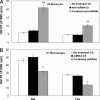Cellular microRNA expression correlates with susceptibility of monocytes/macrophages to HIV-1 infection
- PMID: 19015395
- PMCID: PMC2628373
- DOI: 10.1182/blood-2008-09-175000
Cellular microRNA expression correlates with susceptibility of monocytes/macrophages to HIV-1 infection
Abstract
Although both monocytes and macrophages possess essential requirements for HIV-1 entry, peripheral blood monocytes are infrequently infected with HIV-1 in vivo and in vitro. In contrast, tissue macrophages and monocyte-derived macrophages in vitro are highly susceptible to infection with HIV-1 R5 tropic strains. We investigated intracellular anti-HIV-1 factors that contribute to differential susceptibility of monocytes/macrophages to HIV-1 infection. Freshly isolated monocytes from peripheral blood had significantly higher levels of the anti-HIV-1 microRNAs (miRNA, miRNA-28, miRNA-150, miRNA-223, and miRNA-382) than monocyte-derived macrophages. The suppression of these anti-HIV-1 miRNAs in monocytes facilitates HIV-1 infectivity, whereas increase of the anti-HIV-1 miRNA expression in macrophages inhibited HIV-1 replication. These findings provide compelling and direct evidence at the molecular level to support the notion that intracellular anti-HIV-1 miRNA-mediated innate immunity may have a key role in protecting monocytes/macrophages from HIV-1 infection.
Figures


Comment in
-
Does the presence of anti-HIV miRNAs in monocytes explain their resistance to HIV-1 infection?Blood. 2009 May 14;113(20):5029-30; author reply 5030-1. doi: 10.1182/blood-2009-01-196741. Blood. 2009. PMID: 19443673 No abstract available.
Similar articles
-
miRNA profiles of monocyte-lineage cells are consistent with complicated roles in HIV-1 restriction.Viruses. 2012 Sep 25;4(10):1844-64. doi: 10.3390/v4101844. Viruses. 2012. PMID: 23202444 Free PMC article.
-
Expression of CCR5 increases during monocyte differentiation and directly mediates macrophage susceptibility to infection by human immunodeficiency virus type 1.J Virol. 1998 Jun;72(6):4962-9. doi: 10.1128/JVI.72.6.4962-4969.1998. J Virol. 1998. PMID: 9573265 Free PMC article.
-
Comparison of miRNA Expression Profiles between HIV-1 and HIV-2 Infected Monocyte-Derived Macrophages (MDMs) and Peripheral Blood Mononuclear Cells (PBMCs).Int J Mol Sci. 2020 Sep 22;21(18):6970. doi: 10.3390/ijms21186970. Int J Mol Sci. 2020. PMID: 32971935 Free PMC article.
-
Host hindrance to HIV-1 replication in monocytes and macrophages.Retrovirology. 2010 Apr 7;7:31. doi: 10.1186/1742-4690-7-31. Retrovirology. 2010. PMID: 20374633 Free PMC article. Review.
-
The influence of cytokines, chemokines and their receptors on HIV-1 replication in monocytes and macrophages.Rev Med Virol. 2003 Jan-Feb;13(1):39-56. doi: 10.1002/rmv.369. Rev Med Virol. 2003. PMID: 12516061 Review.
Cited by
-
KSHV-Encoded MicroRNAs: Lessons for Viral Cancer Pathogenesis and Emerging Concepts.Int J Cell Biol. 2012;2012:603961. doi: 10.1155/2012/603961. Epub 2012 Feb 19. Int J Cell Biol. 2012. PMID: 22505930 Free PMC article.
-
A role for microRNA-155 modulation in the anti-HIV-1 effects of Toll-like receptor 3 stimulation in macrophages.PLoS Pathog. 2012 Sep;8(9):e1002937. doi: 10.1371/journal.ppat.1002937. Epub 2012 Sep 20. PLoS Pathog. 2012. PMID: 23028330 Free PMC article.
-
MicroRNA-mediated restriction of HIV-1 in resting CD4+ T cells and monocytes.Viruses. 2012 Sep;4(9):1390-409. doi: 10.3390/v4091390. Epub 2012 Aug 29. Viruses. 2012. PMID: 23170164 Free PMC article. Review.
-
Stem Cell-Derived Exosome as Potential Therapeutics for Microbial Diseases.Front Microbiol. 2022 Feb 14;12:786111. doi: 10.3389/fmicb.2021.786111. eCollection 2021. Front Microbiol. 2022. PMID: 35237239 Free PMC article. Review.
-
MicroRNA biomarkers associated with type 1 myocardial infarction in HIV-positive individuals.AIDS. 2019 Dec 1;33(15):2351-2361. doi: 10.1097/QAD.0000000000002368. AIDS. 2019. PMID: 31764100 Free PMC article.
References
-
- Kedzierska K, Azzam R, Ellery P, Mak J, Jaworowski A, Crowe SM. Defective phagocytosis by human monocyte/macrophages following HIV-1 infection: underlying mechanisms and modulation by adjunctive cytokine therapy. J Clin Virol. 2003;26:247–263. - PubMed
-
- Kedzierska K, Crowe SM. The role of monocytes and macrophages in the pathogenesis of HIV-1 infection. Curr Med Chem. 2002;9:1893–1903. - PubMed
-
- Orenstein JM, Fox C, Wahl SM. Macrophages as a source of HIV during opportunistic infections. Science. 1997;276:1857–1861. - PubMed
-
- Zhu T. HIV-1 in peripheral blood monocytes: an underrated viral source. J Antimicrob Chemother. 2002;50:309–311. - PubMed
-
- Lewin SR, Kirihara J, Sonza S, Irving L, Mills J, Crowe SM. HIV-1 DNA and mRNA concentrations are similar in peripheral blood monocytes and alveolar macrophages in HIV-1-infected individuals. AIDS. 1998;12:719–727. - PubMed
Publication types
MeSH terms
Substances
Grants and funding
LinkOut - more resources
Full Text Sources
Other Literature Sources
Medical

